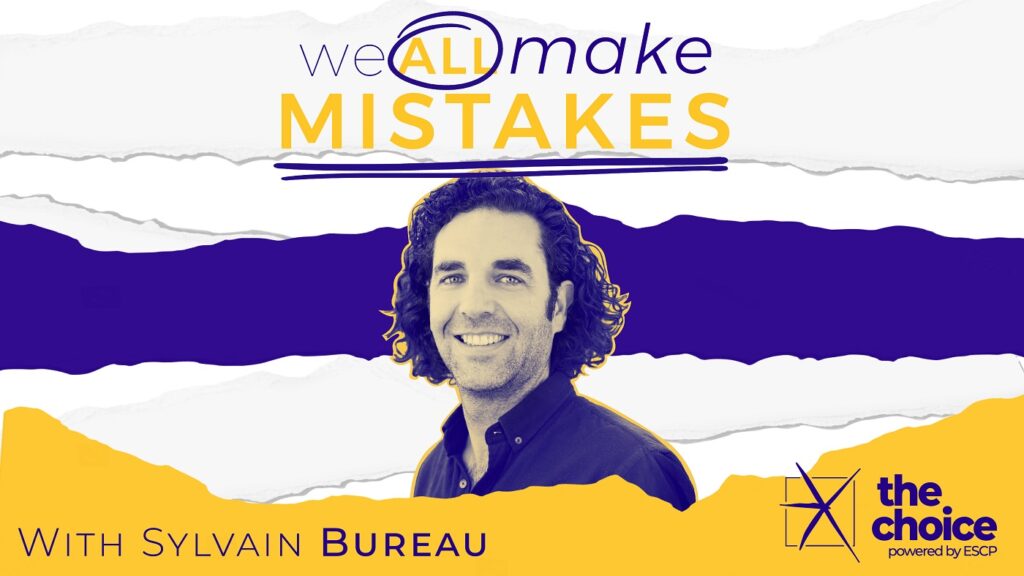In the latest episode of We All Make Mistakes, Professor Ben Voyer talks with Sylvain Bureau, ESCP Business School professor and creator of the Art Thinking method. His groundbreaking work hinges on art, science, and business to help people create “the improbable” and rethink how they engage with mistakes. For Bureau, mistakes are not just inevitable—they are essential to innovation and creativity. “Mistakes are monstrous,” he says, “but they are also a crucial part of the creative process.”
Wondering how embracing your inner ‘monster’ can lead to breakthrough ideas? Sylvain Bureau’s insights will challenge how you view creativity and mistakes.

Turning mistakes into monsters
Mistakes are often seen as failures, but for Sylvain Bureau, they are the raw material of creativity. “As a professor, you have to love mistakes,” Bureau says. “Your students make them, and that’s how they learn. We, as researchers, are constantly dealing with mistakes. It’s part of the process.”
Bureau’s Art Thinking method is designed to help individuals embrace this discomfort and use it to their advantage, creating “the improbable”—ideas that challenge conventions and spark new ways of thinking.
Drawing from examples in the art world, Bureau points out that many famous works of art were initially perceived as flawed. “Take Édouard Manet’s Déjeuner sur l’herbe, for example. At the time, it was full of mistakes in terms of perspective and scale, yet it became iconic because it broke the rules,” Bureau explains. Through Art Thinking, participants are encouraged to deviate from conventional norms, allowing errors to become moments of reflection and creativity.
Learning to love the unknown
At the core of Bureau’s method is what he calls “the Monster workshop.” This exercise helps people confront the unknown and the feeling of discomfort that comes with it. “When you create something new, you don’t know what you’re doing,” he says. “And if you start knowing exactly what you’re doing, it’s no longer creative.”
Bureau’s focus is on creating an environment, or “heterotopia,” where mistakes can be made safely, but not without challenge. “You need a space where people can practice making mistakes, but it’s not about being relaxed—it’s about pushing boundaries and creating something disruptive.”
This approach ties into a broader psychological concept known as “self-monitoring,” where, by anticipating mistakes, people often avoid risk altogether. Bureau’s answer to this is to create environments where risk-taking is not just tolerated, but encouraged, and where mistakes can become opportunities for learning. “We don’t need you to be creative,” he says. “We need you to engage in a creative process where mistakes are part of the journey.”
Find moments where you don’t know what you’re doing, where things feel complicated, but you keep pushing. That’s where creativity happens.
Art Thinking in business
Art Thinking is not just an abstract concept; it has real-world applications in business. Bureau highlights how some of the most innovative products, such as the iPhone, were created through a process similar to Art Thinking. “The iPhone wasn’t born out of a need. It created a new demand,” he explains. “Disruptive products often don’t respond to existing consumer expectations—they challenge them.”
Through his Improbable seminars, Bureau has worked with companies across various sectors, from luxury to banking, helping them harness the power of creativity to foster innovation. “Art Thinking can help businesses move away from a focus on short-term metrics and towards a more transformational approach. It’s about creating something new, not just improving on what already exists.”
Embrace your monsters
When asked what advice he has for students, entrepreneurs, and future leaders, Bureau emphasises the importance of stepping out of comfort zones. “Learn to be bad,” he says. “Find moments where you don’t know what you’re doing, where things feel complicated, but you keep pushing. That’s where creativity happens.” He encourages aspiring innovators to seek out spaces where they can experiment and challenge existing norms.
However, Bureau also warns that embracing creativity means facing criticism. “If no one dislikes what you’re doing, it’s a sign that maybe you’re not innovating enough,” he says. According to Bureau, resistance and discomfort are often the best indicators that you’re onto something truly new and transformative.



